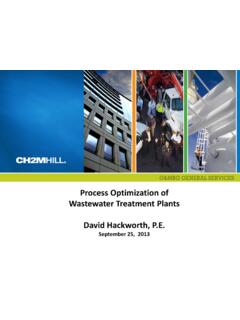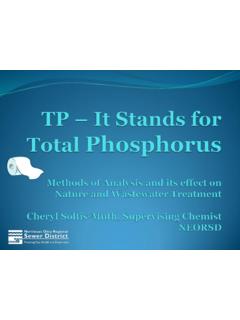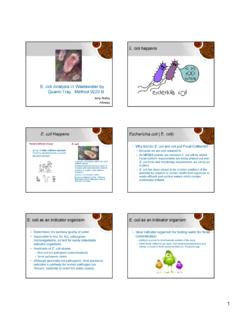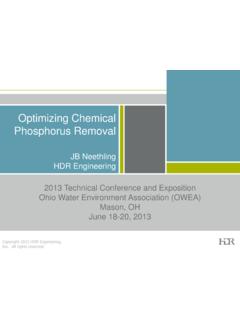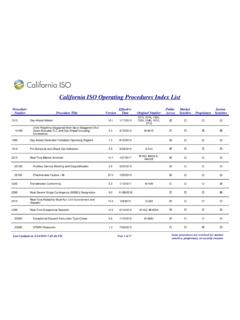Transcription of Anaerobic Digestion and Co-Digestion Optimization
1 Copyright 2013 by CH2M HILL, Inc. alW BG062211121245 ORLA naerobic Digestion and Co-Digestion OptimizationByTodd Williams, PE, BCEER esiduals Resource Recovery Global Technology LeaderAndTim Shea, PE, PhD, BCEEOhio Water Environment Association Biosolids ConferenceColumbus, OHDecember 5, 2013 Copyright 2013 by CH2M HILL, Inc. Outline Basics Mixing Preventing Digester Overflows Addition of FOG and HSW Case Studies2 Copyright 2013 by CH2M HILL, Inc. Digester Basics The operator s work begins after the design and construction are completed. This discussion assumes that these steps were done correctly not always the case. The basic information needed for digester start-up and operation is found in the Manuals of Practices of WEF (MOPs) for Anaerobic Digestion , starting with MOP 16, Anaerobic Digestion Manual of Practice , published in the late 1980s. Co-Digestion is an emerging practice, and there is no MOP available yet just experience. However there are the lessons learned at a number of facilities that can be applied.
2 This is our focus 2013 by CH2M HILL, Inc. Co-Digester Basics Co-Digestion programs have evolved from the realization that some wastes are better introduced directly to the digester rather than via the sewer into the headworks. Such wastes can be piped directly to Digestion , or more commonly as hauled wastes received via tankage for pre-treatment, blending and pre-heating with sludge as digester feedstock. The largest such programs are found in the mid-west USA at places such as Des Moines, IA, in operation over 20 years. Many other utilities have ventured into FOG/HSW waste handling including Johnson County, KS; Gwinnett County, GA; East Bay MUD, CA; Fresno, CA; Davenport, IA; Hershey, PA The waste receiving and handling practices used at these facilities provide many lessons learned for newer 2013 by CH2M HILL, Inc. Co-Digestion Lessons Learned: Knowledge of the individual wastes to be accepted what are a waste s characteristics, variabilities and biomethane production potential.
3 Contractual basis for acceptance have a specification to describe the basis for acceptance or rejection of a load. Assay procedures have a standard procedure to ensure that each load received is within specification. Outlet for the biogas have established uses in place for the added biogas production. Receiving storage capacity it is always cheaper to storage waste than to store gas. Additional gas hold-up in Co-Digestion will likely occur, reducing the density of the digesting liquid and increasing 2013 by CH2M HILL, Inc. Most Existing Digestion Systems Are Not Designed for Co-Digestion : The scale of a Co-Digestion program will change over time as the viability and reliability of a program is built. Multiple categories of wastes to be received may require multiple waste storage tanks. Waste receiving, blending and pre-heating operations must be scaled to the size of the program, often a guess, so phasing is often a consideration. Digester design should but often doesn t provide additional head space and overflow capacity for when the unexpected happens.
4 Secondary digester capacity is useful/essential for balancing flows to dewatering. Other examples are provided later in this 2013 by CH2M HILL, Inc. alW BG062211121245 ORLD igester MixingDigester Mixing Concepts Too little mixing can allow pockets of gas to accumulate, creating density gradients Too much mixing can entrain gas on a wider scale, creating density gradients Temperature gradients and variability in feeding, increasing density gradients Rapid rise foam formation results from excessive and rapid lowering of density8 Digester Mixing Concepts ( ) There will be some foaming in a digester under the best of circumstances Co-digestates like FOG and food wastes add to the potential for nuisance foaming Digesters should be designed to accommodate some nuisance foaming Increasing mixing energy input has been a tempting panacea for digester designers9 Pump Mixing or Nozzle (Jet-Mix) MixingAdvantages of Hydraulic Mixing Provides sufficient mixing energy (eliminates dead spots) Maintains solids in suspension and re- suspension Chopper pumps macerate rags and debris accumulation (Vaughn Chopper Pump)
5 Controls foam problems more effectively than gas mixing systems Reduces routine cleaning (minimal solids accumulation on digester bottom) Easy retrofit of existing digester tanks (equipment located outside of digester) Special ventilation or electrical requirements not required Rotatable nozzles (adjust according to scour locations, Jet-Mix only) System requires least amount of submerged equipment (except for submersible mixers) Low explosive hazard during system maintenance (compared to gas mixing)Hydraulic Mixing Systems10 Pump Mixing or Nozzle (Jet-Mix) MixingDisadvantages of Hydraulic Mixing Limited history in digesters; excellent history in mixing sludge tanks Nozzle cranks penetrating walls of digester (Jet-Mix only) Slightly higher energy usage thanconfined gas systemsHydraulic Mixing Systems11 Mechanical Mixing Systems Draft Tube Mixers (Eimco and WesTech) Center Mixers (Lightning/Philadelphia) Peripheral Mixers (Omnivore) Linear Motion Mixers (Ovivo)12 Mechanical Mixing SystemsAdvantages of Mechanical Mixing System provides a less explosive-hazard environment compared to gas mixing Provides sufficient mixing energy for various tank sizes and configurations VFD pumps can alternate speed according to digester solids contentsDisadvantages of Mechanical Mixing More prone to clogging with rags and other large debris Formation of rag balls clog downstream pumps and piping Sensitive to liquid level in tank (mixing not as effective) Replacement of digester covers required to retrofit existing system (center mixer system)
6 Reinforcement of digester cover required to handle heavy weight and forces generated by mixer (center mixer and roof-mounted draft tubes)13 Gas Mixing Systems Bubble Gun System (IDI Atara) Perth (Envirex) Draft Tube (Walker) CRP System (Chicago Pump Co.)14 Gas Mixing SystemsAdvantages of Gas Mixing Most commonly used mixing system Mixing intensity regulated by throttling gas flow Complete mixing possible with unconfined gas mixing systems, but only IDI Atarawill guarantee performance Potentially less power consumption than mechanical mixing systemsDisadvantages of Gas Mixing Gas compressors, nozzles, and diffusers prone to plugging Excessive foaming and grit accumulation experienced Explosive characteristics of digester gas (O&M more difficult) Costly retrofit for existing digesters (addition of gas compressors and piping) Inefficient mixing below gas injection level prevents grit from remaining in suspension System requires maintenance of different types of equipment compressors, etc.
7 Proprietary mixing systems15 Mixing Parameters in Digesters GER (Gas Evolution Rate) is driven by microbiological activity: Area-specific as gas always rises (Mixing Energy/area-time) Increases with greater height to diameter ratio RRFR (Rapid Rise Foam Formation Rate) is driven by GER (Gas Evolution Rate) Mechanical MEI (Mixing Energy input) Each sludge and digester design is a unique combination and present a unique set of s the Mixing Energy Sweet Spot?Mixing Energy Input RRFRGEROver-Mixing ZoneRRFR = Rapid Rise Foam Formation RateGER = Gas Evolution RateHere?17 Key Points on Digester Mixing Gas evolution rate increases in proportion to mixing energy input Digester over-mixing is a wide-spread concern and contributes to foam production. More work and more detailed information required to select appropriate digester mixing systems. Better performance results from feeding digesters as continuous as possible, especially with FOG and high-strength organic wastes added to the feed.
8 Can expect to see More pumped hydraulic jet mixing systems with VFDs (variable frequency drives) LMMs as a path forward. Different energy for process needs with grit suspension . Grit removal + LMM may become more 2013 by CH2M HILL, Inc. alW BG062211121245 ORLD igester Overflows Causes and Control MeasuresVolume Expansion & Density Reduction from Gas Can Lead to Scenes Like This!Why?21 Factors with Volume ExpansionPotential Causes Changes in rate or composition of feed Changes in mixing regimen Power outage/shutoff of mixing Inadequate or excessive heating Rapid pressure dropsPotential Safeguards Pressure relief valves Emergency surface overflows Foam suppression sprays Increased headspace in gas plenum Rapid transfer piping to lower liquid levelNote that some of the safeguards are nonfunctional at reduced liquid density22 Rapid Rise Foam Formation EventFlowRateDuration, hoursFlow Reduction starts after Shutoff of FeedDeclining Leg of EventRising Leg of Event23 Rapid Rise vs.
9 Chronic Foaming Rapid-rise foaming: Frothy sludge with high gas holdup can reduce the density to half that of sludge. Rapid increase in flow rate (as much as 10-fold more than inflow) Rapid increase signals operation reaction Extended decrease in the flow rate that can last as long as a day Digesters usually not designed to accommodate Chronic or normal foaming: A relatively continuous phenomenon Digesters are typically designed to handle chronic or normal foaming using such measures as foam breakers with scum nozzles24 Foam Breaker with Scum Nozzle Vaughan Foambuster (Above) and Scum Nozzle (Below) for control of surface scum and foam buildup25 Foam Management Begins with Start-Up Start-up is a time of transition Transitions are the most critical periods for foam formation generating gas hold-up A proven example start-up protocol is found in the WPCF (now WEF) MOP 16 Anaerobic Digestion Manual of Practice No. 16 . This document addresses the start-up procedures and is crystal clear on what is Process Start-Up MOP 16 and common sense dictate that all systems and equipment must be operational before startup.
10 The monitoring program and laboratory capacity must be ready to go. The staff must be fully trained. A contingency plan must be in place. One person must be in charge Everyone must buy in to the alternative outlets for gas & liquid ..Pressure Relief Valve & Flame Arrester EmergencyOverflowCan be rendered non-functional due to frothy sludge28 Gas Draw-Off PipeCan be part of the cause of an imbalanced loading29 Frothy Sludge Over the Digester Wall .. And Onto the Ground31 Control Measures Have an approved start-up plan with buy-ins Have a start-up team with a chain of command that means business Avoid premature start-up at all cost. Avoid complacency at all cost Visit other sites where start-ups have been done and capture the lessons 2013 by CH2M HILL, Inc. alW BG062211121245 ORLA ddition of FOG and HSW ConsiderationsFOG and HSW Addition Considerations Overall Benefits of Use of FOG as a Resource Improve sewer and WRRF performance Provides revenue stream from tip fees Will generate significant amounts of biogas at low hydraulic loading in Anaerobic Digestion Biogas production when coupled with co-generation can result in significant cost savings Biogas use from FOG addition in CHP can reduce GHG footprint and energy dependence Other Considerations Get a handle on quantities and characteristics available Start slow Modeling digester performance/biogas production can easily be done Consider impact on entire wwtpprocess train during design34 Key Considerations for Utilizing FOG Resources Characteristics and form of FOG or high strength wastes to be received for Co-Digestion Reliability.
